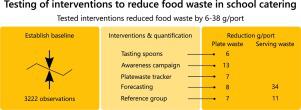Resources, Conservation and Recycling ( IF 11.2 ) Pub Date : 2021-10-20 , DOI: 10.1016/j.resconrec.2021.105997 Christopher Malefors , Niina Sundin , Malou Tromp , Mattias Eriksson

|
Food waste is a problem that needs to be addressed to achieve sustainable development. There is a need for interventions that can reduce food waste, including in organisations already aware of the food waste problem. Swedish school canteens have experience of food waste reduction, but need tools to achieve further reductions. This study tested four interventions (tasting spoons, awareness campaign, a plate waste tracker and a guest forecasting tool) designed to reduce food waste in school canteens. Each intervention was introduced in two school canteens, while seven school canteens acted as a reference group. The interventions were compared with baseline food waste before the intervention and with the reference group. All interventions reduced total food waste (by 6 to 44 g/guest) compared with the baseline, but the reference group also reduced its food waste. The awareness campaign reduced plate waste most, by 13 g per portion, which was 6 g/portion more than the plate waste reduction in the reference group. The forecasting and plate waste tracker interventions reduced serving waste most, by 34 and 38 g/portion, compared with 11 g/portion in the reference group. Some interventions also had an effect on waste fractions they were not designed to target, affecting the total waste by shifting the waste. Interventions should always be seen in a context and be implemented in combinations that increase overall sustainability. Thus forecasting is an effective way to reduce serving waste, plate waste tracker and awareness campaign are effective tools to reduce plate waste in school canteens.
中文翻译:

测试干预措施以减少学校餐饮中的食物浪费
食物浪费是实现可持续发展需要解决的问题。需要采取可以减少食物浪费的干预措施,包括在已经意识到食物浪费问题的组织中。瑞典学校食堂有减少食物浪费的经验,但需要工具来进一步减少食物浪费。该研究测试了旨在减少学校食堂食物浪费的四种干预措施(品尝勺、提高意识运动、盘子浪费跟踪器和客人预测工具)。每项干预措施都在两个学校食堂进行,而七个学校食堂作为参考组。将干预措施与干预前的基线食物浪费和参考组进行了比较。与基线相比,所有干预措施都减少了食物浪费总量(每人减少了 6 至 44 克),但参考组也减少了食物浪费。宣传活动减少的餐盘浪费最多,每份减少 13 克,比参照组减少餐盘浪费的次数多 6 克/份。预测和餐盘浪费跟踪器干预减少了最多的服务浪费,分别为 34 和 38 克/份,而参考组为 11 克/份。一些干预措施还对它们并非设计目标的废物部分产生影响,通过转移废物影响废物总量。干预措施应始终在特定背景下看待,并以提高整体可持续性的组合方式实施。因此,预测是减少服务浪费的有效方法,餐盘垃圾追踪器和宣传活动是减少学校食堂餐盘垃圾的有效工具。每份减少 13 克,比参照组减少的版材浪费多 6 克/份。预测和餐盘浪费跟踪器干预减少了最多的服务浪费,分别为 34 和 38 克/份,而参考组为 11 克/份。一些干预措施还对它们并非设计目标的废物部分产生影响,通过转移废物影响废物总量。干预措施应始终在特定背景下看待,并以提高整体可持续性的组合方式实施。因此,预测是减少服务浪费的有效方法,餐盘垃圾追踪器和宣传活动是减少学校食堂餐盘垃圾的有效工具。每份减少 13 克,比参照组减少的版材浪费多 6 克/份。预测和餐盘浪费跟踪器干预减少了最多的服务浪费,分别为 34 和 38 克/份,而参考组为 11 克/份。一些干预措施还对它们并非设计目标的废物部分产生影响,通过转移废物影响废物总量。干预措施应始终在特定背景下看待,并以提高整体可持续性的组合方式实施。因此,预测是减少服务浪费的有效方法,餐盘垃圾追踪器和宣传活动是减少学校食堂餐盘垃圾的有效工具。预测和餐盘浪费跟踪器干预减少了最多的服务浪费,分别为 34 和 38 克/份,而参考组为 11 克/份。一些干预措施还对它们并非设计目标的废物部分产生影响,通过转移废物影响废物总量。干预措施应始终在特定背景下看待,并以提高整体可持续性的组合方式实施。因此,预测是减少服务浪费的有效方法,餐盘垃圾追踪器和宣传活动是减少学校食堂餐盘垃圾的有效工具。预测和餐盘浪费跟踪器干预减少了最多的服务浪费,分别为 34 和 38 克/份,而参考组为 11 克/份。一些干预措施还对它们并非设计目标的废物部分产生影响,通过转移废物影响废物总量。干预措施应始终在特定背景下看待,并以提高整体可持续性的组合方式实施。因此,预测是减少服务浪费的有效方法,餐盘浪费跟踪器和意识运动是减少学校食堂餐盘浪费的有效工具。干预措施应始终在特定背景下进行,并以提高整体可持续性的组合方式实施。因此,预测是减少服务浪费的有效方法,餐盘浪费跟踪器和意识运动是减少学校食堂餐盘浪费的有效工具。干预措施应始终在特定背景下看待,并以提高整体可持续性的组合方式实施。因此,预测是减少服务浪费的有效方法,餐盘垃圾追踪器和宣传活动是减少学校食堂餐盘垃圾的有效工具。











































 京公网安备 11010802027423号
京公网安备 11010802027423号